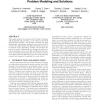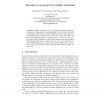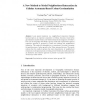367 search results - page 31 / 74 » Cellular automata |
DAC
2004
ACM
14 years 9 months ago
2004
ACM
This paper presents the Quantum-Dot Cellular Automata (QCA) physical design problem, in the context of the VLSI physical design problem. The problem is divided into three subprobl...
MFCS
2009
Springer
14 years 3 months ago
2009
Springer
Abstract. Cellular automata (CA) are discrete, homogeneous dynamical systems. Non-surjective one-dimensional CA have
nite words with no preimage (called orphans), pairs of dieren...
ICCS
2007
Springer
14 years 2 months ago
2007
Springer
Local spatial interaction (i.e. neighborhood interaction) between land-use types is an important component in Cellular Automata -based urban geosimulation models. Herein a new meth...
DATE
2006
IEEE
14 years 2 months ago
2006
IEEE
— In this paper, we present a test generation framework for testing of quantum cellular automata (QCA) circuits. QCA is a nanotechnology that has attracted significant recent at...
GLVLSI
2005
IEEE
14 years 2 months ago
2005
IEEE
This paper describes a SPICE model development methodology for Quantum-Dot Cellular Automata (QCA) cells and presents a SPICE model for QCA cells. The model is validated by simula...



